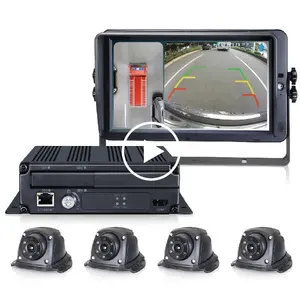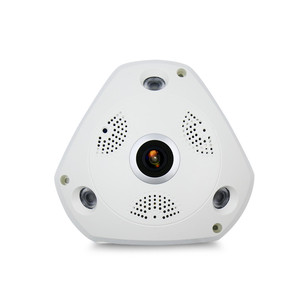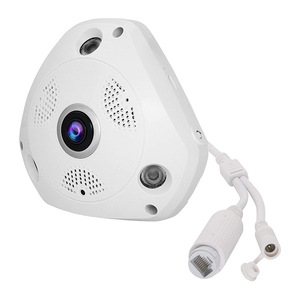(1221 products available)











































































































































































































































A wireless 360-degree camera bird view system is a technological advancement in the automotive industry, particularly in parking sensors and backup cameras. This system provides drivers with a comprehensive view of their surroundings, effectively eliminating blind spots and facilitating safer maneuvering, especially in tight spaces. The camera system comprises multiple cameras strategically placed around the vehicle to create a seamless 360-degree view that can be accessed wirelessly, reducing the need for cumbersome cables and connections.
These systems have become increasingly popular in modern vehicles, enhancing overall safety and convenience. Various types of wireless 360-degree camera systems are available, including bird's eye view systems, 3D surround view systems, and advanced parking guidance systems.
Bird's Eye View Systems:
Bird's eye view systems utilize four cameras mounted on the vehicle's corners. These cameras work together to create a composite image, giving drivers a top-down view of their surroundings. This view is particularly useful for parallel parking and low-speed maneuvers in crowded areas.
3D Surround View Systems:
3D surround view systems offer a more advanced perspective by using six to eight cameras placed around the vehicle. These cameras capture real-time footage and process it to generate a three-dimensional representation of the vehicle and its environment. 3D surround view systems are beneficial for parking in tight spaces and detecting nearby obstacles or pedestrians.
Advanced Parking Guidance Systems:
Advanced parking guidance systems combine wireless 360-degree camera technology with additional sensors and artificial intelligence algorithms. These systems can automatically detect parking spaces, provide visual and auditory warnings of obstacles, and guide the vehicle into the parking space. These systems are designed to alleviate stress and improve overall parking accuracy.
Modular Wireless Systems:
Modular systems offer flexibility and customization options. Depending on the model, they may include two or more cameras and various monitor sizes. This allows users to tailor the system to their specific needs and preferences. Modular wireless systems are ideal for retrofitting into older vehicles or for commercial fleets requiring customized solutions.
Integration with Driver-Assist Technologies:
Some advanced 360-degree camera systems integrate with other driver-assist technologies, such as parking sensors, blind-spot monitoring, and lane departure warning systems. This synergy enhances overall vehicle safety and provides comprehensive support to drivers.
These are the specifications for the 360-degree camera bird view system wireless.
Resolution
High-definition (HD) resolution is crucial in a 360-degree camera because it provides clear and precise images. Some cameras have resolutions of up to 4K, which gives even more detail. This is especially helpful in situations where maintaining a secure environment is essential. High-definition cameras provide a wider view without sacrificing image quality, allowing for better visibility of the whole area.
Field of view (FOV)
The field of view (FOV) indicates how broad the camera's coverage is. A wider FOV allows for more excellent monitoring of larger areas. This is especially helpful in security applications where seeing as much as possible is essential. A camera with a broad FOV can cover more ground, reducing blind areas and offering a more comprehensive view.
Night Vision
Night vision capabilities are essential for monitoring low-light settings. They enable visibility in complete darkness or low-light conditions by using infrared (IR) illumination. This ensures that the area is adequately monitored at all hours, day or night.
Motion Detection
Motion detection technology in 360-degree cameras is essential for security purposes. Motion detection enables real-time alerts to be sent when movement is found in the monitored area. This allows for quick reactions to possible security breaches. Furthermore, motion detection helps to save storage space by only recording events that cause movement.
Weather Resistance
Weather resistance is a vital feature of 360-degree cameras, especially for outdoor use. These cameras are built to withstand severe weather conditions such as rain, snow, and extreme temperatures. Weather resistance ensures that the camera's operation is consistent, regardless of the environment. This is especially important for outdoor surveillance, where the camera must perform reliably in various weather conditions.
Wireless Connectivity
Wireless connectivity, such as Wi-Fi or Bluetooth, is a significant feature of 360-degree cameras. This allows for easy installation and flexibility in camera placement. The absence of wires means that the camera may be positioned in various locations without the need for complicated wiring setups. Furthermore, wireless connectivity permits smooth interaction with other devices, such as smartphones or tablets, allowing for remote monitoring and control from anywhere.
PTZ (Pan-Tilt-Zoom) Capability
PTZ (Pan-Tilt-Zoom) capability is a crucial feature of some 360-degree cameras. This allows for remote control of the camera's movement, including panning, tilting, and zooming. PTZ capability provides more excellent flexibility and control over monitoring. Operators may focus on specific areas of interest by remotely adjusting the camera's viewpoint.
Here are some maintenance practices for the 360-degree camera bird view system wireless.
Regular Cleaning
Regular cleaning of the 360-degree camera is essential to maintain optimal performance and image quality. Dust, dirt, and debris can accumulate on the camera's surface and lenses over time, leading to decreased visibility and clarity. Use a soft, lint-free cloth to clean the camera's body and lenses regularly. Cleaning the casing and lenses will help to prevent the accumulation of dirt and dust, which could obscure the camera's vision and reduce image quality.
Firmware Updates
Keeping the camera's firmware up to date is essential for optimal performance and security. Manufacturers often release firmware updates that include bug fixes, performance improvements, and new features. These improvements ensure the camera operates at its best. Regularly check for firmware updates on the manufacturer's website and follow the provided instructions to install them. This ensures your camera has access to the most recent features and improvements.
Inspecting Connections
Regularly inspect and ensure that all connections, such as power and network connections, are secure. Loose connections can cause the camera to malfunction or lose connectivity. Check the cables and connectors for any signs of wear or damage and replace them if necessary. Maintaining reliable connections is essential for the camera's consistent performance and connectivity.
Environmental Considerations
Consider the environmental conditions in which the camera is installed. Extreme temperatures, high humidity, or exposure to harsh elements can affect the camera's performance and lifespan. Ensure the camera is installed in an appropriate location that meets the manufacturer's specifications for optimal performance and durability.
Regular Functional Checks
Perform regular functional checks to ensure the camera operates correctly. Test the live view, recording functionality, and motion detection features to ensure everything works as intended. This helps to identify and address any potential issues promptly.
To choose the right 360-degree camera bird view system, a business must understand its needs and consider several factors.
Coverage Area
Consider the coverage area to be monitored. A bigger place will require more cameras or a more advanced system to cover all corners without blind spots.
Image Quality
High resolution is a must, especially for important places like entrances. Clear images let users see details better. If the area has low light, look for cameras that can capture good quality in dim lighting.
Wireless vs. Wired Systems
Wireless systems are easier to install and more flexible. They are ideal for larger or complex areas. However, they might have interference or bandwidth issues. Wired systems are more reliable but can be challenging to install in some places.
Night Vision
Ensure the system has night vision capabilities. This is crucial for monitoring places with little light to capture clear images, whether day or night.
Durability and Weather Resistance
For outdoor use, choose cameras built to last in different weather. Check the IP rating for protection from dust and water.
Field of View
A broader field of view means the camera can see more area. Choose cameras with an extended viewing angle to cover more space and reduce blind spots.
Storage Options
Decide between local storage, like SD cards, or cloud storage. Local storage is affordable, while cloud storage gives access from anywhere. Think about how much storage is needed based on recording time and quality.
Integration with Other Systems
The new system can work with current alarms or door phones. This gives more security and lets users see alerts or videos on one screen.
Power Source
Consider the availability of power sources. Some systems have battery-powered cameras for locations without power outlets. Others have cameras with Power over Ethernet (POE) capabilities, allowing data and power through one cable.
Installation and Setup
Consider the ease of installation and setup. Some systems require professional installation, while others are DIY-friendly. Look for systems with user-friendly interfaces and straightforward installation processes.
Budget
Determine the budget for the 360-degree camera system. Consider the initial cost, ongoing subscription fees for cloud storage (if applicable), and any additional accessories or installation costs. Find a balance between the required features and the available budget.
Many 360-degree camera systems for cars are DIY-friendly. Even those with conventional wired systems can be replaced with some suitable wireless kits. The replacement process is straightforward. Always go through the manufacturer's manual to understand how to go about the process. Below is a general guide on how to install a 360-degree camera system for birds' views.
The tools needed for this process include a screwdriver set, trim removal tools, electrical tape, a drill (if mounting cameras), and a 360-degree camera system bird view guide.
Prepare the Vehicle
Get the right tools and the camera system. The tools needed for this process include a screwdriver set, trim removal tools, electrical tape, a drill (if mounting cameras), and a 360-degree camera system bird view guide. Start by disconnecting the vehicle's battery. This will ensure that no electrical short circuits occur during the installation process. Find a secure location to mount the four cameras. This is usually at the front, rear, and side doors. Some people prefer mounting them at the side mirrors. Wash the camera placements and ensure they are dry. This will ensure that dirt doesn't interfere with the camera's quality.
Install the Cameras
Follow the manufacturer's instructions to position each camera, ensuring optimal coverage. Some systems come with adhesive mounts that make the process easier. If they are not, one might need to drill to secure the cameras properly. Route the camera cables along the vehicle's trim, securing them to avoid interference with other components. Connect each camera to the control unit following the provided wiring diagram.
Connect the Control Unit
Locate a suitable location for the control unit, often near the dashboard. Connect the power cables of the control unit to the vehicle's electrical system, ensuring secure connections. Plug in the cables from each camera to their respective ports on the control unit. Ensure all connections are secure to prevent signal loss.
Monitor Installation
Find a suitable location for the monitor installation. Connect the control unit's output to the monitor, ensuring a secure connection. Some people prefer using adhesive or mounting brackets to install the monitor. Reconnect the vehicle's battery after completing the installation. Turn on the vehicle and test the system to ensure all cameras display correctly.
Q1: How is a 360-degree bird view camera installed?
A1: The camera can be mounted on the front or rear license plate holder, above the rearview mirror, or on the front bumper. Some cars have the system pre-installed, while others require aftermarket installation?
Q2: Can any car get a 360-degree camera system?
A2: Yes, especially cars that do not come with the system pre-installed. Aftermarket systems are available and can be installed in most cars irrespective of their make or model?
Q3: Does a 360-degree camera system help with parking?
A3: Yes. It provides a composite view of the surroundings of the vehicle, helping drivers to park without hitting any obstacles. The system also has guidelines that show the possible path the car can take?
Q4: Can the 360-degree camera bird view system be used off-road?
A4: Yes, it can. The system can be helpful in off-road situations by providing a complete view of the terrain around the vehicle, helping drivers to navigate tight spaces and obstacles carefully?
Q5: Is the 360-degree camera bird view system available in different models?
A5: Yes, there are several models available. Each has its features, such as image resolution, night vision capabilities, and connectivity options. Buyers should choose a model that fits their needs and budget?